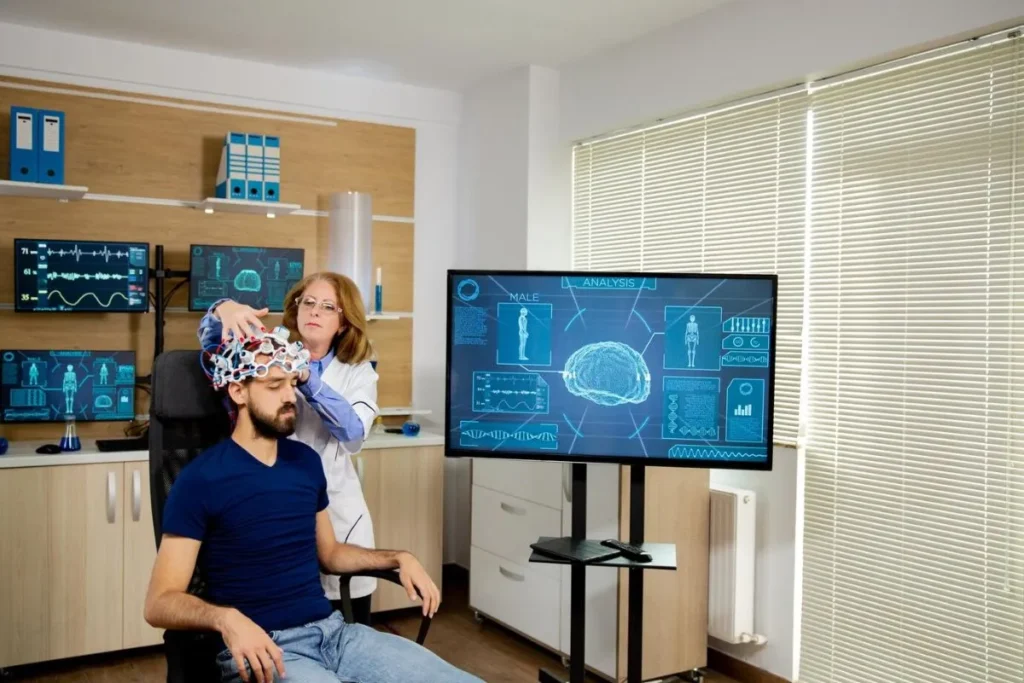Brainwave-Driven Music Experiences are revolutionizing how we engage with music. By leveraging neural data, we can create highly personalized auditory journeys. These advances are opening new frontiers in music, technology, and neuroscience.
In this article, we will explore how Brainwave-Driven Music Experiences work. We will delve into the latest innovations, techniques, and their impact on entertainment. Additionally, we will look at the intersection of sensory performance and emotional engagement.
As we progress, we will also analyze the technology behind these experiences. From EEG sensors to AI algorithms, there’s a lot to unpack. Stay tuned for an in-depth journey into this exciting field.
The Science Behind Brainwave-Driven Music Experiences
Understanding brainwaves is crucial for creating Brainwave-Driven Music Experiences. Brainwaves are electrical impulses in the brain, measured using an electroencephalogram (EEG). These impulses fall into different frequency ranges, such as alpha, beta, theta, and delta.
Each frequency range is associated with different mental states. For example, alpha waves are linked to relaxation, while beta waves are associated with concentration. By mapping these signals, we can create music that responds to specific mental states.
The process begins with EEG sensors capturing brainwave activity. Advanced algorithms then analyze this data in real-time. The output can be used to adjust musical parameters like tempo, pitch, and volume, creating a dynamic and personalized experience.
Technological Innovations
Technological advancements are at the heart of Brainwave-Driven Music Experiences. Modern EEG sensors are more accurate and compact. These devices have become user-friendly, enabling widespread adoption.
Artificial Intelligence (AI) also plays a crucial role. AI algorithms can identify patterns in brainwave data. They can predict how certain music will affect mental states, allowing for real-time adjustments.
Moreover, machine learning models are becoming more sophisticated. These models can learn from user interactions, continually enhancing the musical experience. The synergy of EEG technology and AI is a game-changer in this field.
Application in Entertainment
Entertainment is a significant beneficiary of Brainwave-Driven Music Experiences. This technology transforms concerts, gaming, and virtual reality (VR). Imagine a concert where the music changes based on the audience’s emotional state.
In gaming, brainwave-driven music can make gameplay more immersive. The soundtrack can adapt to the player’s stress levels, enhancing the overall experience. Similarly, in VR, the environment can change based on the user’s mental state, creating a more engaging experience.
These applications also have therapeutic potential. Music therapy can be enhanced by aligning musical elements with the patient’s brainwaves. This alignment can make therapy sessions more effective and tailored to individual needs.
Sensory and Emotional Integration
Creating Brainwave-Driven Music Experiences involves integrating sensory and emotional responses. Our brain processes music in a way that affects our emotions and overall sensory experience, creating a deep connection between the listener and the sound.
By tapping into this process, we can maximize emotional engagement, crafting musical experiences that resonate on a profound level. This approach has the potential to revolutionize how we interact with and perceive music.
Neuroscience research shows that music activates multiple areas of the brain. These areas are responsible for emotions, memory, and even motor functions, providing a rich tapestry of neural activity to explore.
Leveraging this knowledge, we can design music that evokes specific emotional responses, enhancing the listener’s experience. This can be particularly powerful in therapeutic settings, where tailored music can aid in mental health treatments and cognitive rehabilitation.
Moreover, these experiences can be customized. Users can select the type of emotional journey they want, tailoring the experience to their current mood or needs.
Whether it’s relaxation, motivation, or focus, brainwave-driven music can be tailored to individual preferences, offering a personalized soundtrack for various activities.
This customization can enhance productivity, improve mood, and even assist in achieving meditative states, making it a versatile tool for personal well-being.
Additionally, advancements in wearable technology can further enhance these experiences. Devices that monitor real-time brain activity can adjust the music dynamically, creating an adaptive and responsive musical environment.
This synergy between technology and music opens up new possibilities for immersive and interactive auditory experiences.
Maximizing Performance
One of the key benefits of Brainwave-Driven Music Experiences is their ability to maximize performance. Whether in sports, work, or academic settings, tailored music can enhance focus and productivity.
Studies have shown that specific types of music can improve concentration and cognitive performance. By aligning this music with brainwaves, the effect is amplified. This approach can help in tasks that require high levels of focus and mental clarity.
Furthermore, this technology can aid in stress management. Music that aligns with alpha waves can promote relaxation, reducing stress and anxiety. This benefit is particularly valuable in high-pressure environments.
Practical Applications
- Athletics: Enhance training sessions by aligning music with brainwave activity.
- Workspaces: Boost productivity by using music tailored to mental states.
- Education: Improve learning outcomes with personalized auditory cues.
Challenges and Future Directions
While Brainwave-Driven Music Experiences offer immense potential, they come with challenges. One major challenge is the accuracy of brainwave reading. Despite advancements, EEG sensors can still produce noisy data.
Another challenge is the ethical considerations. The use of neural data raises privacy concerns. It’s crucial to ensure that data is handled responsibly and transparently.
Looking ahead, the future holds exciting possibilities. As technology evolves, we can expect more accurate and accessible brainwave-driven experiences. Collaboration between technologists, musicians, and neuroscientists will be key to unlocking the full potential of this field.
Innovation and Collaboration
Innovation in Brainwave-Driven Music Experiences will depend on collaboration. Diverse expertise will be needed to solve existing challenges and explore new frontiers. Partnerships between tech companies and academic institutions can drive progress.
Moreover, open-source platforms can accelerate innovation. By sharing data and algorithms, researchers can build on each other’s work. This collaborative approach can lead to breakthroughs that might not be possible in isolation.
Finally, user feedback will be invaluable. Real-world applications can provide insights that lab-based research cannot. Continually adapting based on user experience will refine and perfect brainwave-driven music technologies.
Promising Future
As we’ve seen, Brainwave-Driven Music Experiences have transformative potential. Innovations in EEG technology, AI, and neuroscience are driving this revolution. The applications in entertainment, therapy, and productivity are vast and varied.
However, it’s essential to navigate the challenges carefully. Ethical considerations and data accuracy must be top priorities. With collaborative efforts, the future of brainwave-driven music looks promising.
Embrace this exciting field. Stay informed and engage with ongoing advancements. As technology evolves, so too will our understanding and utilization of brainwave-driven experiences.
Frequently Asked Questions
What are brainwave-driven music experiences?
Brainwave-driven music experiences use EEG technology to create music that responds to your mental state, providing a personalized auditory experience.
How accurate are EEG sensors in these applications?
While modern EEG sensors are more accurate, they can still produce noisy data.
Can brainwave-driven music enhance productivity?
Yes, aligning music with brainwaves can maximize focus and cognitive performance, aiding in productivity and stress management.
Are there ethical concerns regarding neural data?
Yes, the use of neural data raises privacy concerns, requiring responsible and transparent data handling practices.
What does the future hold for this technology?
Future advancements will bring more accurate and accessible experiences, thanks to ongoing innovation and collaboration in the field.




